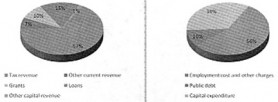i. to guard and protect the stability achieved for the economy and the country in the immediate term and for the long term;
ii. to lay the basis for continued economic growth, social development, and improvement in the quality of life enjoyed by Guyanese; and
iii. to pursue the catalytic changes that would enable realisation of rapid transformation into the truly modern and prosperous Guyana which is aspired.
The Minister announced that the National Accounts have been rebased to 2006 prices with critical inputs from a National Economic Survey of Business Establishments conducted in 2006 and a nationwide Household Budget Survey conducted over the period October 2005 to September 2006. Gross Domestic Product based on 1988 and 2006 prices was as follows:
![]() Overall real growth is projected at 4.4% in 2010 with the non-sugar economy and the sugar economy projected to grow by 3.4% and 19.8% respectively.
Overall real growth is projected at 4.4% in 2010 with the non-sugar economy and the sugar economy projected to grow by 3.4% and 19.8% respectively.
Monetary Policy & Inflation
The Minister also announced that the Bureau of Statistics had completed the technical work required for an updating of the basket of goods and services underlying the Consumer Price Index (CPI) based on the Household Budget Survey. The new CPI series is being introduced from January 2010 and reflects decreased weights for food and medical care among others, and increased weights for transport, housing and furniture.
The Minister announced that the rate of inflation for 2010 is projected at 4% (based on new CPI series) compared with a target of 5.2% and an actual of 3.6% in 2009 (based on old CPI series).
Balance of Payment
The Minister projects a deficit of US$11.3Mn on the overall balance of payments, compared with a surplus of US$234.4Mn in 2009. On the trade side, merchandise exports are projected to increase by 1.08% to US$776.5Mn while merchandise imports are projected to increase by 4.26% to US$1,219Bn. With net imports of services at US$131.3Mn, and private transfers of US$310Mn., a net deficit of US$263.8Mn is projected as the balance on the current account.
The capital account is projected to have a surplus of US$252.5Mn in 2010 (US$454.0Mn in 2009). In this account, a net inflow of US$257.8Mn is expected from medium and long term capital while a net outflow of US$35Mn is expected on short term capital.
Revenue and Expenditure
 Revenue and expenditure for the year 2010 is represented by the following graphs respectively:
Revenue and expenditure for the year 2010 is represented by the following graphs respectively:
Source: Estimates of the Public Sector
The size of the 2010 budget is $142.8Bn which is 11.28% more than 2009 latest estimate and 10.78% higher than the 2008 budget.
Ram & McRae’s comments
1. Achievement of the rebasing of the country’s national accounts is commendable. Statistics produced would be more relevant and one hopes that timeliness would now improve.
2. The Minister noted that the current El Niño conditions have affected the sowing of paddy and consequently, is projecting a fall in rice production. Inexplicably, no impact is reported on sugar, currently being affected by a shortage of water. Indeed, the current weather pattern can affect not only the growth of the current crop, but ratooning as well.
3. Merchandise imports are projected to be 2.75 times merchandise exports in 2010, lower than in 2009 but higher than in 2008. This leaves our economy far too reliant on remittances and borrowings, if the cycle is to be reversed any time soon.
4. The Minister stated that Government remains focused on maximising rapid progress towards the attainment of the Millennium Development Goals (MDGs), and while he gave a review of progress and intentions of various sector strategies, he failed to state whether Guyana was on target for attainment of the MDGs, what corrective action may be necessary and possible, and the policy changes to achieve these.
5. With LCDS and the National Competitiveness Strategy being the new mantra, the Poverty Reduction Strategy Paper once again failed to get a mention in the Minister’s speech. The increase in the size of the budget is 2.47 times the projected growth in GDP while the tax to GDP ratio moves from 24.95 to 24.23. Government Size, measured as government spending as a percentage of the GDP at current basic prices (rebased), increases from 35.68 to 36.49. It should be noted however that expenditure by state-owned enterprises would not be included Government spending but would be included in the rebased GDP. Consequently, a more thorough analysis would reveal much higher level of Government participation in and direct control of the economy.
6. Until the Bureau of Statistics is perceived as professional and independent, there will remain a lack of trust in national statistics. Key economic indicators are announced by the Minister, often unsupported by empirical evidence.






